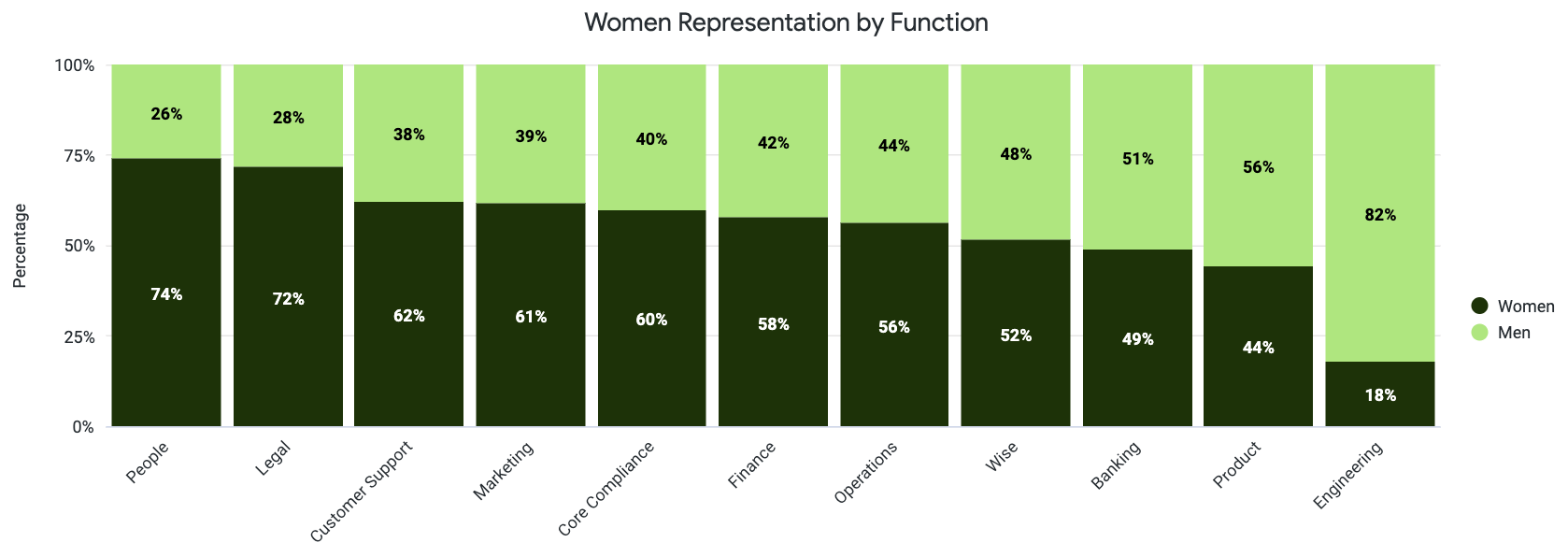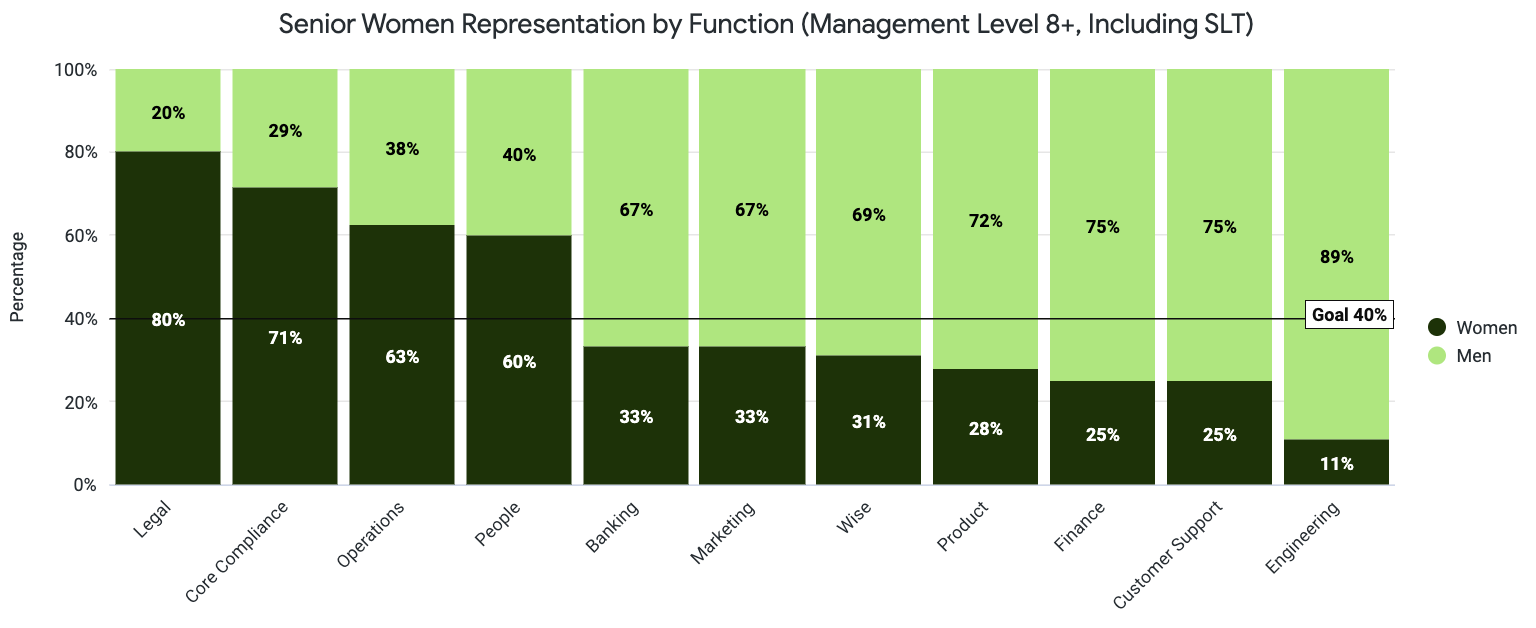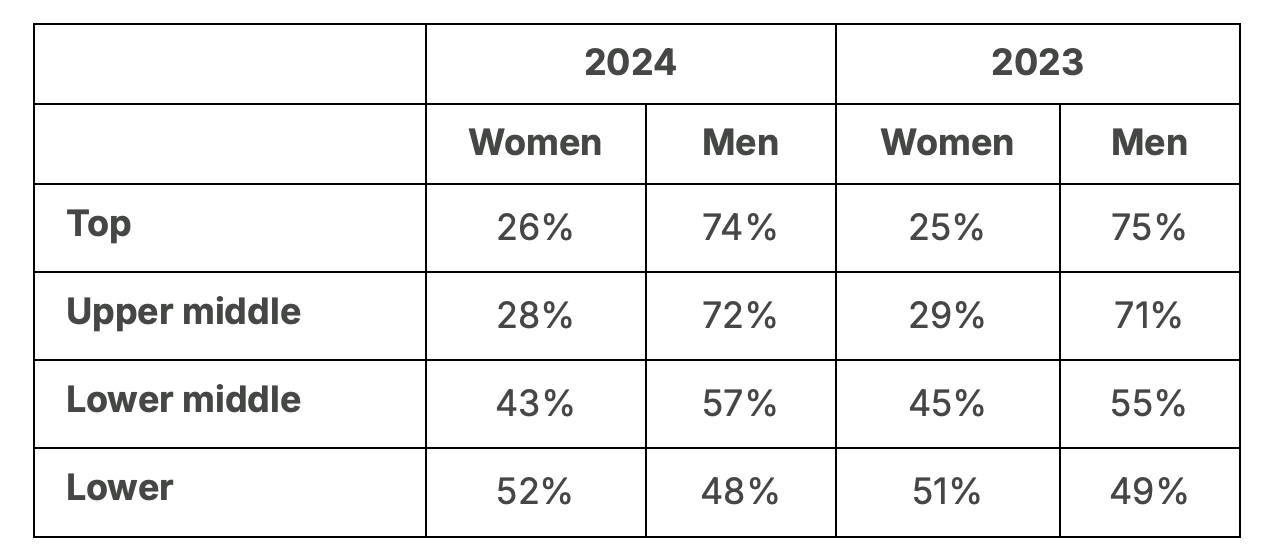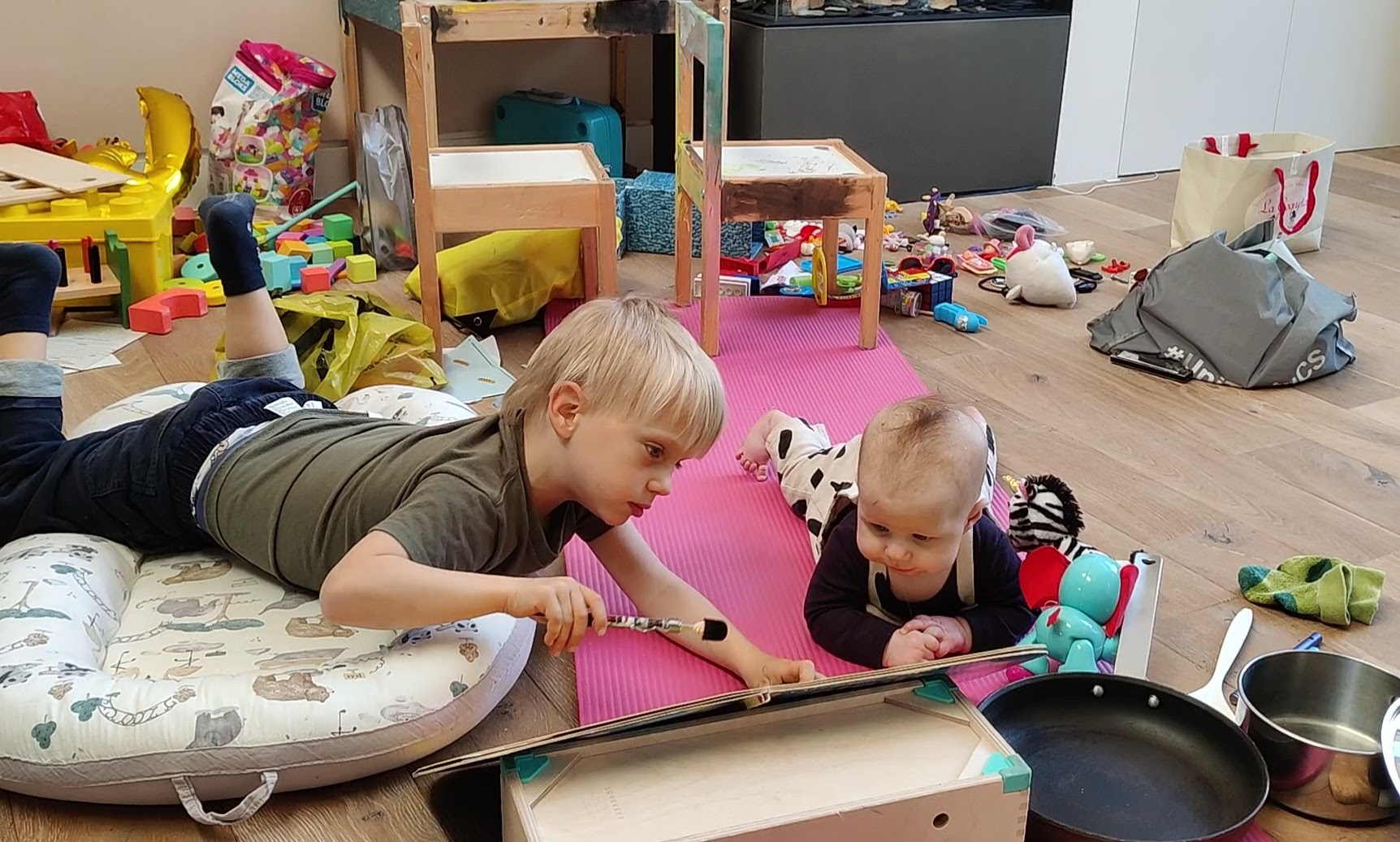At Wise, our vision is money without borders. In order to build the future of global money, we need a team that’s as diverse as the customers we serve.
In September 2020 we signed the HM Treasury’s Women in Finance Charter, pledging to improve the representation of women in the Wise senior leadership team. The Women in Finance Charter was created to increase women’s representation across financial services, especially in the most senior management levels of their organisations.
This report covers the work we’re doing at Wise to achieve better women’s representation, our UK reporting on the Gender Pay Gap and our progress towards our Women in Finance Charter goal.
Continuing to increase our representation of women at Wise
Overall, women represent 52% of Wisers and we are pleased to have maintained 46% women among our Leads (managers). Our focus continues to be on increasing our representation of women in our most senior leadership levels (Level 8+ or Director and above) which is currently at 31.62% (up 1.5 pp YoY). Our aspirational goal is to reach 40% by the end of 2025.
We have achieved 30% representation of women at our Executive Committee level (C-suite) and 50% at our Executive Board level, (up 6pp YoY), demonstrating the continued progress we have made over the last 3 years, particularly at the top of our organisation.
As of today, we are pleased that all our functional teams are made up of more than 40% women globally, with the exception of the Engineering team only.

The functional teams that are currently below the 40% Senior leadership aspirational goal have set specific OKRs and action plans dedicated to improving the representation of Senior women leaders at Wise across hiring, retention and career development opportunities.

Some of the function specific initiatives include mitigating any potential biases in their people-related processes, more deliberate outreach to senior women candidates and diversity-related recruitment organisations, and ensuring talent management and career growth opportunities for their pipeline of Senior women.
This year we continued to evolve our Gender Pay Gap audits and analysis in more granular detail function by function, and by different demographics, in order to inform our analysis and insights before and after salary reviews. We also ensured additional “speed bumps” for checking and challenging decisions around potential gender pay differentials, through Leads (manager) training and communications.
Since our report last year, we developed our Women’s representation data reporting and analytics capability to help us understand where we need to continue to focus across hiring, promotions, and retention levers across each function at a more granular level. This has helped us better understand the root causes of any gaps or challenges per functional team.
Areas where we’ve seen improvement since last year:
- Voluntary attrition rate of Senior women has reduced by -6pp to 5.5%.
- Increased our attraction activity in direct sourcing candidates who are Senior women leaders.
- Closely tracked gender and ethnic diversity in candidate shortlists for leadership roles particularly.
- We hired 38% Senior women YoY.
- Embedded our Inclusive Principles into recruiter and hiring manager training and expectations.
- Continued to run DEI sessions on topics such as disability and neurodiversity inclusion and faith inclusion to ensure practical advice and tips to support inclusive hiring practices.
- Continued to build on our support for the Senior women community, with monthly roundtable networking lunches to increase connection, career progression opportunities and inviting our women Leadership Team and Non-Executive Directors. Topics included effective leadership, customer centricity and leading authentically.
- Prioritised developing more robust succession planning per function, developing our internal diverse leadership pipelines across the organisation; including newly established women’s and ethnic minority mentoring programmes across parts of the organisation.
- Launched our first Senior women’s executive 121 coaching programme this year with over 35 participants.
The areas we’re continuing to focus on are:
- We continue to invest in the area of hiring Senior women in a number of ways, including building capacity in our leadership recruitment team in order to focus on long-term relationship building with external senior women leaders. We are also planning to host a Senior women’s fintech event next year as part of our attraction strategy.
- Continuing to improve our support for our Senior women leadership pipeline in order to improve our promotions to Senior leadership level (L.8). Our overall promotion rate for women was 29% this year (28% for men) and 52% of all promotions were women this year. For Leads the promotion rate was 33% for women (31% for men) and 53% of all Leads promotions were women which are all strong results. However our Level 8 promotions for women were 31%.
- Therefore our deliberate focus will remain on developing the leadership pipeline in mid to Senior (Level 7) women’s retention, growth and career development opportunities. We plan to build out our talent management tools and performance management processes to ensure more structure, detail and transparency across Wise. We believe this will further increase focus on Senior women’s leadership pipeline,their career development and future Senior women’s promotions as a result.
- We continue to build out our succession planning practices,going deeper into each functional team with action plans for internal and external benches and sharing insights on our gender mix in particular at the senior levels.
- Launching a family friendly project to aid additional support for maternity leavers and returners and their Leads to manage the transition back into work. We aim to enhance the transition back into the workplace moving forwards with parental coaching and more Leads training. This year we are piloting a parental coaching programme with the view to launch this offering globally.
Our focus for 2025 will be continuing with deliberate actions across our functional teams to ensure more consistency, sustainability and scalability in our approaches; strengthening our internal diverse pipeline of leaders and continuing to broaden our hiring strategies to attract the widest set of talent pools available.
Continuing to increase our investment in women in tech
We are focused on developing a diverse early careers pipeline particularly for engineering and tech-related roles. We know we can make a huge difference in increasing access, aspiration and inspiration for those from underrepresented backgrounds in the tech industry, including women.
We run our WiseWomenCode program each year to help accelerate women’s paths into technology-related careers. We welcome women, non-binary folks and trans women to our offices for 3 days of knowledge sharing, side-by-side coding sessions and networking to provide a glimpse into the fintech industry.
We encourage applications from current students, those having recently switched careers and those who return to the workforce after extended leave. We seek to hire as many potential participants as possible. This year, we have expanded our reach across Budapest, London, Singapore and Tallinn - bringing the opportunity to over 60 women and non-binary participants globally. Since 2022, we have hired 9 participants into full-time roles already.
In 2025, we'll be partnering with the University of Texas to open the opportunity for 2 women/non-binary and trans-women participants to travel to London to attend our WiseWomenCode programme. They'll be partnered with Wise mentors for the remaining of the academic year once back in Austin.
In addition to this, we support those from underrepresented socio-economic backgrounds in the tech industry at secondary schools and Universities via our Wise Scholarships initiative. For example, we partner with Clapton Girls Academy to offer work experience for year 12 students in both Tech and Non Tech tracks.
This not only provides financial support to our recipients, but offers mentoring and networking opportunities throughout the academic year. With Wise Scholarships, we are encouraging a deeper shift in the tech industry in breaking down financial barriers,particularly for those from low-income backgrounds. In 2024 we awarded 7 students with such scholarships across London, Tallinn and Tartu, and wish to grow this next year.
Continuing to reinforce our inclusive culture
This year our employee engagement survey has seen very high sentiment scores for inclusion - coming in the top 5% against the benchmark of global technology companies.
Creating safe spaces, peer connectivity and thought leadership is key to driving our inclusive culture forwards. We have 12 Global Wise Communities (Employee Resource Groups) dedicated to fostering a diverse and inclusive workplace including Queerwise (LGBTQIA+), Black Wisers Network and Wise Women to name a few. We also profile a diverse range of women and non-binary Wisers from all communities across many different internal and external speaker events and communications such as Diana from our Wise Women and Latinx Wiser Network, and Omolade from our Black Wiser Community.
Our Wise Women Community and Wise Women in Engineering Community, which are both open to women, trans and non-binary Wisers, hold regular events to support career growth, networking and skills development. This year, they came together for our biggest Wise Women in Engineering event which had 60 Wise Women Engineers during our annual Mission Day. Women communities across other functional teams have also found it impactful in bringing women together to build peer-to-peer support and career development sessions. For instance, women in the Wise Platform team hosted an executive presence and personal brand workshop this year. Overall this year, we have implemented a stronger governance structure across all 12 global DEI communities, to ensure better alignment with our DEI objectives and Wise mission including better representation, development and retention of Wise Women.
We are further investing in our Senior women and non-binary external community in particular, including peer networking lunches and hosting industry events such as Women in Product, Control-Alt-Connect and Brunch & Learns for the wider fintech women’s community.
Continuing to tackle Wise’s gender pay gap
The data below provides our UK Gender Pay Gap as of the 5th April 2024 snapshot date as per the requirements of the Equality Act 2010 (Gender Pay Gap Information) Regulations 2017.
On 5th April 2024, Wise had 1017 people working in the UK, based out of the London office. 38% of the team were women, 62% were men. The proportion of women to men since 2023 has not changed since the last publication of this blog.
We are able to identify the key driver of our Gender Pay Gap, when we split our population into technical teams (Product, Engineering and Analytics) and non-technical teams (Servicing, Operations, Core Functions). Our non-technical teams are relatively evenly balanced at 55% women to 45% men. However, there is a higher proportion of men to women at 71% to 29% (a slight improvement on last year where the ratio was 76% to 24%) in our technical teams, as is prevalent in the rest of the technology sector. These roles tend to pay higher salaries, thus, continuing to focus on improving our pipeline of women talent in these areas will be key to closing the gap.

*Data for 2024 is taken as of April 2024 payroll, on the 5th April 2024
*Data for 2023 is taken as of April 2023 payroll, on the 5th April 2023
*To calculate this data, we have used the legal and binary form of gender for team members. We plan to report on the basis of employees’ gender identity once our minimum thresholds for reporting are met.
Our mean hourly pay gap has decreased by another 0.9 percentage points, however our median hourly pay gap has increased by almost 2.5 percentage points. This is primarily driven by an increase in more men into senior Risk, Compliance and Tech roles and the increase of more women in our junior marketing roles.
Therefore, whilst we’re pleased to see the average pay gap narrowing as a result of work we’ve put into hiring and salary review decisions, we want to continue our efforts to close these gaps moving forwards.
Are bonuses included in the pay gap?
Stock is offered as a key part of our compensation package. It's a long term incentive and one of the ways employees can benefit from the growth in value of our business. That means all our employees have a share in our mission and a responsibility to make our business a success.
Since listing as a public company in 2021, stock awards are provided as Restricted Stock Units (RSUs) based on pre-determined amounts for each role and level. As part of our commitment to transparency, we share all of our stock levels with our Wisers, which are always granted in £ GBP so we ensure Wisers globally benefit from consistency and locations with large currency changes do not lose out.
For the Gender Pay Gap calculations, we are required to use the value of equity based on when the tax liability arises for the employee. For stock options (NSOs) which Wise offered between 2011 and 2022, this is when options are exercised. It is important to highlight that it’s an employee’s own choice to exercise their stock options, as well as when, and at what price. Therefore, it is based on choices an individual makes, such that the calculations are not reflective of any bias in awards, and are dependent on the price at when an employee chooses to exercise their stock options or the value of an RSUs at vesting.
The table below provides the values of the NSOs and RSUs that were exercised in the reporting period reported, as well as all other forms of payment offered at Wise which are classified as bonuses under the UK Gender Pay Gap reporting requirements. These other payments are the employee job referral scheme (approximately £1200), a £1000 payment alongside our six-week paid sabbatical for employees who serve four years at Wise, and relocation allowances.
Whilst the data below fulfils our reporting requirements for the Bonus Gap, we do not believe, as based on the reasons stated above, that this is indicative of any potential inherent biases. We also are still in the process of transitioning employees to granting our stock annually, versus on a 4-year basis. This will enable a more appropriate view of our bonus gap, since all employees will be eligible to receive new stock on an annual basis, as well as greater flexibility within our stock plans. We are continuing to monitor pay gaps for men and women alike.
Gender Bonus Gap Calculation (Statutory Reporting)

*Data for 2024 is taken as of April 2024 payroll, on the 5th April 2024
*Data for 2023 is taken as of April 2023 payroll, on the 5th April 2023
What does the gender pay split look like at Wise?
As per the UK Gender Pay Reporting requirements, everyone in scope is split into four equal quartiles from the lowest to the highest paid. This year, women representation has increased in the top quartile, however as we have hired more men this year, representation of men has increased in the middle two quartiles. There is also a slight increase (1%) of women in the lowest quartile, although the percentage split of men and women in this quartile remains fairly even. Overall, we are continuing to build a strong pipeline to increase Senior women representation across the business and to achieve this we are focussed on increasing the representation of women at the top quartile.

Why do we have a pay gap?
Wise has over 6,000 people across 11 key locations, and since we last reported in 2023 our UK team, based out of the London office, has continued to grow, exceeding 1000 employees.
We know that a major factor impacting the gender pay gap is that a significant proportion of our higher paying roles are within tech-related functions- our Engineering and Product teams. Hence our goals focus on increasing the number of Senior women across all functions where we are below 40% representation (Level 8+ or Director and above) and especially for tech-related teams in increasing our internal diverse leadership pipeline at Wise.
The 3 main levers we have to accelerate the pace of change are: hiring, retention and career development.
How are we tackling this?
We’re committed to monitoring and reducing Wise’s gender pay gap and meeting our Women in Finance Charter goal of 40% Senior women leaders by the end of 2025.
Here are a few example initiatives that we’re continuing to deliver in 2025:
1. Widening the recruitment funnel and continuing to headhunt Senior women
- So far we have hired 38% Senior women YoY and continue to expand our current attraction and sourcing strategy for hiring Senior women and those from underrepresented groups, particularly in tech-related roles
- Utilising recruitment partnerships with diversity related organisations, agencies and diverse referral drives, for example women in tech networks, Coding Black Females and She Can Code this year
- Sharing our job vacancies more widely across different talent pools and diverse networks
2. Enhancing our inclusive recruitment process and mitigating any potential biases
- Continue to enhance our inclusive job description templates to help reduce bias in the language and criteria of our roles, with diversity as a key discussion point added to all our hiring manager intake meeting templates
- Further embedding our inclusive hiring principles within our interview training for all hiring managers and embedding bias mitigation techniques at each recruitment stage
- Running DEI training on a range of DEI related topics including uncovering unconscious biases, particularly for hiring leads. Ensuring a range of attraction strategies are implemented to increase Senior women and diversity in all its forms in our candidate pipelines.
- We have added extra “speedbumps” or checkpoints as part of our salary review processes in order to check and challenge pay decisions with gender and ethnicity pay gaps in mind.
3. Developing our internal diverse leadership pipeline, including women future leaders
- Continuing to ensure the representation of women and those from other underrepresented groups feature in all our functional succession planning and talent management processes
- Ensuring the representation of women and those from other underrepresented groups feature in all our Leads training programmes and leadership initiatives
- Sustaining the retention of our Senior women through tailored career development opportunities, sponsorship and executive coaching opportunities, depending on individual needs and ambitions
- Increasing leadership accountability in all management levels with our OKR plans per function - particularly where we see an underrepresentation of women in leadership, i.e. across Engineering, Finance and Product teams
Developing our Wisers competencies for diversity, equity and inclusion
This year we have expanded and enhanced our DEI learning offerings to build on the foundations we established last year. Key DEI learning components are now integrated into both mandatory and on-demand training programs for Leads and we have launched monthly DEI learning sessions for all Wisers globally. These sessions address critical DEI topics such as Disability and Neurodiversity Inclusion, Becoming an Anti-Racist Workplace and Fostering Faith Inclusion and have had an average NPS score of 91. They are deliberately co-designed and co-facilitated with our DEI Communities and offer practical scenario based learning, in strengthening our speak up culture and consciously mitigating biases.
This year our employee engagement survey has seen very high sentiment scores for Diversity, Equity & Inclusion- we are in fact in the top 5% against the benchmark of global Tech companies for Inclusion for the second year in a row.
FAQS:
What is the gender pay gap?
The gender pay gap is the difference in average hourly earnings between men and women working within the same organisation. It shows us how women and men are being paid across teams and helps us understand the representation of women in senior roles, and in the highest paid areas of the business such as Product and Engineering.
Companies with more than 250 employees in the UK have to report their Gender Pay Gap figures annually on the 5 April, as a snapshot of the previous year’s data. The report has been prepared in accordance with the requirements of the Equality Act 2010 (Gender Pay Gap Information) Regulations 2022.
How is the gender pay gap different from equal pay?
The 1970 Equal Pay Act made it illegal to pay people doing the same job differently based on gender, a ruling which has since expanded to cover other protected characteristics. Wise is fully compliant with the Equal Pay Act. The gender pay gap, however, is a broader overview of the salaries and benefits earned by men and women within Wise, regardless of their role or seniority.
What sort of stock does Wise offer employees?
Up until 2022, Wise typically granted Non-qualified stock options (NSOs) to its employees. In the UK, Wise originally offered employees share options via the EMI or CSOP schemes, which are employee tax advantage schemes designed for smaller companies.
Since April 2022, all new stock grants at Wise are offered as Restricted Stock Units (RSUs).
Our RSUs and NSOs are defined as a bonus by the UK Government, so any stock options sold from this scheme are included in the bonus numbers below. Options sold by people holding EMI and CSOP options are not included.
Glossary of terms
NSOs
NSOs are Non-Qualified stock options.They are a type of employee stock option where you pay ordinary income tax on the difference between the grant price and the price at which you exercise.
EMI
The Enterprise Management Incentive (EMI) is a tax-advantaged share option scheme designed for smaller companies. The EMI is a share option scheme that enables companies to attract and retain key staff by rewarding them with equity participation in the business.
CSOP
The CSOP is a tax qualified discretionary option plan under which a company may grant options to any employee to acquire shares at an exercise price which must be no less than the market value of the shares on the grant date.
This publication is provided for general information purposes only and is not intended to cover every aspect of the topics with which it deals. It is not intended to amount to advice on which you should rely. You must obtain professional or specialist advice before taking, or refraining from, any action on the basis of the content in this publication. The information in this publication does not constitute legal, tax or other professional advice from Wise Payments Limited or its affiliates. Prior results do not guarantee a similar outcome. We make no representations, warranties or guarantees, whether express or implied, that the content in the publication is accurate, complete or up to date.
*Please see terms of use and product availability for your region or visit Wise fees and pricing for the most up to date pricing and fee information.
This publication is provided for general information purposes and does not constitute legal, tax or other professional advice from Wise Payments Limited or its subsidiaries and its affiliates, and it is not intended as a substitute for obtaining advice from a financial advisor or any other professional.
We make no representations, warranties or guarantees, whether expressed or implied, that the content in the publication is accurate, complete or up to date.













